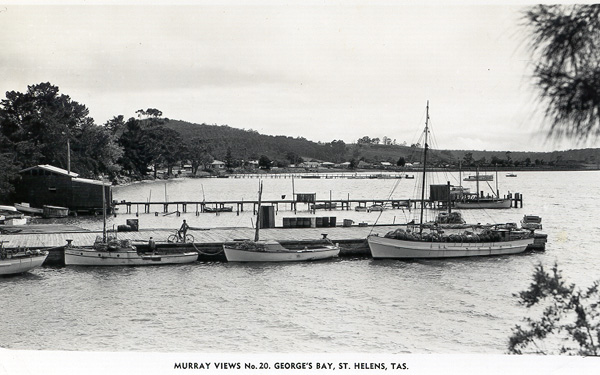 |
 |
|
St Helens
The Kunnarra Kuna tribe of Tasmanian Aborigines were the main users of the land between the Georges River and the Golden Fleece River that is now the township of St Helens. It was open level forested land with plenty of game and a good supply of fresh water. Georges Bay supplied the Aborigines with plenty of shell fish and ample scale fish for their needs. St Helens was cold and frosty in the winter but it was only five miles to the coast where the ambient temperature was much warmer because of the East Australian current moving south which warms the coastline. The tribe preferred to move to the coast in winter hence the large number of midden remains in the sand dunes. In 1824 Thomas Scott named the Georges River, as it is known today, as Geordies River. Three years later George Amos from Swansea walked the coast line from Swansea to Ansons Bay looking for good grazing land. He did not find any, but settled at Swansea. In 1830 John Gould, government explorer and surveyor, walked through St Helens to the Blue Tier where he missed the presence of cassiterite, the ore of tin. He named Goulds Country. From this date, grants of land were made to early settlers. In 1833 a whale fishery was established at Binalong Bay, and is believed to have lasted about two years. The next year St Helens received its name, when a military station was established at Akaroa to intercept escaped convicts who found their way to St Helens Point from Port Arthur. The troops were ordered to leave in 1848. Until this date the north-east had mainly been a farming area, but change arrived in 1874 when George Renison Bell found tin close to St Helens. This started a rush of miners to the area in search of the 'grey gold'. Large amounts of earth were sluiced away on the land between St Helens and Goshen. The tin-laden water was brought by earthen races and wooden flumings from the upper (North and South) Georges Rivers and the Groom River to the working sites. Eventually the miners followed the streams to the top of the Blue Tier where they found casiterite embedded in the soft granite rocks. It was not long before hundreds of hard rock mines were opened and heavy machinery was transported over unformed roads by horses. The bagged tin was returned to the port at St Helens. In 1875 Sir William Crowther visited the mines and recorded in his diaries being present at a Band of Hope meeting in the Union Church at Goulds Country. Crowther travelled back and forth over the road to the Blue Tier, attending accident victims and sick persons. A number of Chinese worked on the alluvial mines close to St Helens. In 1902 the municipality of Portland was established. It was administered from Lottah then from Goulds Country, and in 1956 moved to St Helens which remains the administrative centre for the Break o'Day municipality. St Helens has always been an attractive place to holiday and has become a favourite place for retired persons. St Helens has a comprehensive History Room where all aspects of its history have been collected and displayed for the public. Further reading: K Burns, Let's Talk about the St. Helens District, Tasmanian Tourist Council, 1972; P and K Burns, A walk of history around St Helens, St Helens, 1980; and Then and Now: 100 years of schooling in St. Helens 1874-1974, St Helens, [1974]; G and S Miller, Of Rascals and Rusty Relics, Hobart, 1979; J Scott, Celestial Sojourn, St Helens, 1997; B Smith, Reflections of Benjamin Smith, Perth, Tasmania, 1920; G Webb, Pyengana a New Country, Hobart, 1975; P Steel, The Centenary of Portland 1832 to 1932, Launceston, 1934; Records and oral histories in St Helens History Room. Peter Burns |
Copyright 2006, Centre for Tasmanian Historical Studies |
